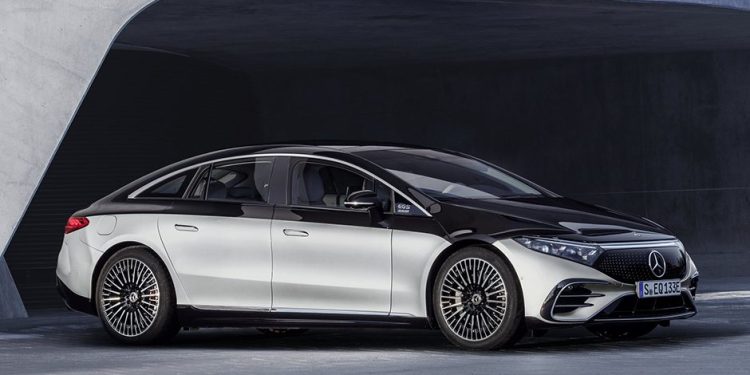Mercedes unveils sleek EQS EV with 770km of range
Following extensive coverage of both its enormous 56-inch ‘Hyperscreen’ and the rest of its cabin, Mercedes-Benz has finally shown off its new fully electric EQS sedan in full.
As predicted by many, the production EQS looks like a somewhat neutered version of the three-pointed star’s EQS Concept from 2019. All the lines are more or less the same, but the car gets a front bumper that ties it in with the rest of the Mercedes line-up, and the rest of its panels make it look like a tweaked S-Class.

But, this isn’t just an S-Class with a silent powertrain. It sits on an all-new platform dedicated to future Mercedes EVs, making this the brand’s first electric car that’s engineered from nose to tail to be an EV. In terms of size, it’s 5265mm is longer than a standard S-Class. The new platform is modular, meaning can be used for vehicles of all shapes and sizes. A smaller EQE is set to come next year, built on the same architecture.
For now, Mercedes has announced two different EQS models; the 450 and the 580 4Matic. The former is rear-wheel drive, and extracts 245kW/568Nm from its solitary permanent magnet synchronous (commonly abbreviated to ‘PSM’) motor, and can hit 100km/h in 6.2 seconds.
The more powerful 580 4Matic, meanwhile is all-wheel drive as the name suggests. It gets 384kW/854Nm from two motors, and subsequently chops the 0–100km/h sprint down to 4.3 seconds. If that’s not quick enough, know that there’s an AMG variant in the works.

Range is a slight enigma, with Mercedes not yet releasing full information about which models are capable of what. The brand has only said the model is capable of 770km, making it the second longest-range electric vehicle on the market behind the Tesla Model S Plaid Plus (which claims to do 837km). It’s not known which model in the line-up actually accomplishes this feat.
While it doesn’t topple the Plaid, that’s still an impressive feat from Mercedes. The EQS achieves its lofty range targets by having a very svelte 0.20 Cd drag coefficient figure, and by top speed on both models being limited to 210km/h. Buyers get either a 90kWh or 107.8kWh lithium-ion battery pack, the latter presumably being the one capable of knocking out over 700km.

It gets 400V charging architecture, meaning it lags a touch behind the 800V functionality of the Porsche Taycan. Hooked up to a 200kW charger, it will go from 10 per cent charge to 80 in just 31 minutes, while 15 minutes of charging is said to be enough to give you 300km of travel.
As reported previously, the EQS packs an enormous amount of kit inside — helping it add to the S-Class’s existing legacy for pioneering tech. Overnight the German marque showed off the EQS’ futuristic new cabin. It features next-gen ‘MBUX’ digital voice assistant, facial recognition cameras pointed at the driver for biometric authentication, 15-speaker Burmester audio, and an enormous 56-inch (1.41 meter) curved infotainment screen — known as the ‘Hyperscreen’.
The screen spans almost from pillar to pillar and is topped by a scratch-resistant cover. It’s actually made up of three smaller screens; a 12.3-inch driver’s display, a 17.7-inch central display, and a 12.3-inch front passenger display (the latter pairing both being OLED screens).
The screen unit packs 12 actuators to provide haptic feedback wherever the operator’s finger touches the screen. And when you’re not using all three screens or their key features, users can programme the screen to show some form of background.
It won’t be standard on all models, for those who aren’t keen for the full tech effect. Ironically the entry-level model looks more like an S-Class inside, with a (still fairly hefty) 12.8-inch primary ‘floating’ screen.

Other notable features in the EQS cabin include the existence of a ‘Power Nap’ feature. If the driver wants a break from longer trips, the car can activate a three-phase function designed to first assist the driver in falling asleep, then keep them asleep, then eventually wake them up.
While it hasn’t been formally confirmed for New Zealand just yet, we expect the EQS to be part of the local line-up eventually. It’s already been announced for Australia, where it will go on sale in December.





